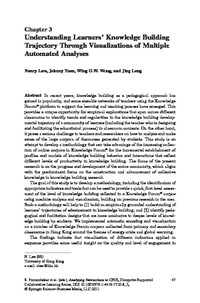Understanding Learners´ Knowledge Building Trajectory Through Visualizations of Multiple Automated AnalysesZu finden in: Analyzing Interactions in CSCL (Seite 47 bis 82), 2010
 |
 |
 Diese Seite wurde seit 1 Jahr inhaltlich nicht mehr aktualisiert.
Unter Umständen ist sie nicht mehr aktuell.
Diese Seite wurde seit 1 Jahr inhaltlich nicht mehr aktualisiert.
Unter Umständen ist sie nicht mehr aktuell.
 Zusammenfassungen
Zusammenfassungen
 In recent years, knowledge building as a pedagogical approach has gained in popularity, and some sizeable networks of teachers using the Knowledge Forum ® platform to support the learning and teaching process have emerged. This provides a unique opportunity for empirical explorations that span across different classrooms to identify trends and regularities in the knowledge building developmental trajectory of a community of learners (including the teacher who is designing and facilitating the educational process) in classroom contexts. On the other hand, it poses a serious challenge to teachers and researchers on how to analyze and make sense of the large corpora of discourses generated by students. This study is an attempt to develop a methodology that can take advantage of the increasing collection of online corpora in Knowledge Forum ® for the incremental establishment of profiles and models of knowledge building behavior and interactions that reflect different levels of productivity in knowledge building. The focus of the present research is on the progress and development of the entire community, which aligns with the predominant focus on the construction and advancement of collective knowledge in knowledge building research.
In recent years, knowledge building as a pedagogical approach has gained in popularity, and some sizeable networks of teachers using the Knowledge Forum ® platform to support the learning and teaching process have emerged. This provides a unique opportunity for empirical explorations that span across different classrooms to identify trends and regularities in the knowledge building developmental trajectory of a community of learners (including the teacher who is designing and facilitating the educational process) in classroom contexts. On the other hand, it poses a serious challenge to teachers and researchers on how to analyze and make sense of the large corpora of discourses generated by students. This study is an attempt to develop a methodology that can take advantage of the increasing collection of online corpora in Knowledge Forum ® for the incremental establishment of profiles and models of knowledge building behavior and interactions that reflect different levels of productivity in knowledge building. The focus of the present research is on the progress and development of the entire community, which aligns with the predominant focus on the construction and advancement of collective knowledge in knowledge building research.The goal of this study is to develop a methodology, including the identification of appropriate indicators and tools that can be used to provide a quick, first level assessment of the level of knowledge building reflected in a Knowledge Forum ® corpus using machine analysis and visualization, building on previous research in the area. Such a methodology will help to (1) build an empirically grounded understanding of learners´ trajectories of advancement in knowledge building; and (2) identify pedagogical and facilitation designs that are more conducive to deeper levels of knowledge building by students. We implemented automatic encoding and visualization on a number of Knowledge Forum corpora collected from primary and secondary classrooms in Hong Kong around the themes of energy crisis and global warming.
The findings indicate that visualization of different indicators applied in sequence provides some useful insight on the quality and level of engagement in online asynchronous discussions. Basic participation statistics at discourse and thread levels are useful in discriminating truncated inquiries from other, more engaging ones. Linear visualization of the time sequence of discourse markers for argumentation, questions and scaffolds sheds light on whether there is evidence of cycles of progressive inquiry. Fine grained identification of subject matter content reveals whether the discussion is likely to be an extensive inquiry or an intensive one. The study also demonstrates a clear need for automated coding and visualization of discourse corpora to be augmented and validated by a review of the actual discourse data by human researchers to yield more in-depth understanding of the knowledge building processes.
 Dieses Kapitel erwähnt ...
Dieses Kapitel erwähnt ...
 Begriffe KB IB clear |  machine learning
, social network analysissocial network analysis
, machine learning
, social network analysissocial network analysis
,  Visualisierung Visualisierung visualization visualization
|
 Anderswo finden
Anderswo finden
 Volltext dieses Dokuments
Volltext dieses Dokuments
 |  Understanding Learners´ Knowledge Building Trajectory Through Visualizations of Multiple Automated Analyses: Artikel als Volltext bei Springerlink ( Understanding Learners´ Knowledge Building Trajectory Through Visualizations of Multiple Automated Analyses: Artikel als Volltext bei Springerlink ( : :  , 2243 kByte; , 2243 kByte;  : :  2020-11-28) 2020-11-28) |
 Anderswo suchen
Anderswo suchen 
 Beat und dieses Kapitel
Beat und dieses Kapitel
Beat hat Dieses Kapitel während seiner Zeit am Institut für Medien und Schule (IMS) ins Biblionetz aufgenommen. Beat besitzt kein physisches, aber ein digitales Exemplar. Eine digitale Version ist auf dem Internet verfügbar (s.o.). Aufgrund der wenigen Einträge im Biblionetz scheint er es nicht wirklich gelesen zu haben. Es gibt bisher auch nur wenige Objekte im Biblionetz, die dieses Werk zitieren.










 Biblionetz-History
Biblionetz-History